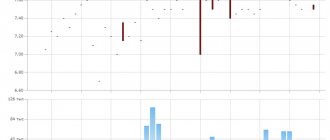Author: Yango.Investments
The US bond market (Treasuries) is the largest and one of the most reliable and liquid in the world. We explain whether the US national debt can grow indefinitely and whether a default on US bonds is possible in principle. Is it true that Treasuries quotes can predict a global recession? How can the situation on the US bond market affect the Russian financial market and regulatory decisions, and why should a private investor monitor the dynamics of Treasuries?
READ IN THE ARTICLE:
✔ What kind of bonds does the US issue? ✔ Who buys US bonds? ✔ How much debt does America have ✔ Could the US bond yield curve predict a recession? ✔ How do US bonds affect the Russian financial market? ✔ Is it worth investing in American government bonds and is a default on the US government debt possible?
© When using site materials and quoting - a link with a URL is required
What types of bonds exist in the USA
The American government bond market trades securities with maturities from 1 to 30 years. Those that trade for up to 10 years are considered medium-term and are called Notes. Up to 30 years - these are long-term Bonds.
There is also a short-term segment: Bills. These are treasury bills that are issued at a discount and redeemed at par. Their circulation period is less than one year.
I'll take a closer look at the short-term ones. All bills have an exact expiration date:
- 1 month;
- 3 months;
- 6 months.
Thus, we have three types of bills in the United States.
Now the mid-term segment. notes has the following timing parameters:
- 1 year;
- 2 years;
- 3 years;
- 5 years;
- 7 years;
- 10 years.
Total 6 types of notes.
Long-term segment:
- 15 years;
- 20 years;
- 30 years.
I have listed the deadlines with which the US Treasury publishes. Any American company can issue bonds for 16 years. Information resources dedicated to investments often use the gradation described above - it is convenient to use it to look at the profitability of government securities rather than commercial ones.
US bonds are distinguished not only by maturity, but also by issuer:
- Municipal bonds are debt securities issued by states and cities. There are general and profitable ones. General are used to cover debts and have no collateral. Income bonds are issued to attract financing for large projects and are ensured by the presence of a real source of income.
- Corporate bonds are debt securities of commercial companies. They are less reliable than state and municipal ones, but more profitable.
- Savings bonds are debt securities issued by the federal government that can only be redeemed by the federal government. This type is not traded on the secondary market (their sale to anyone is impossible) and is purchased by the investor only during the auction.
There are other types of US bonds: mortgage-backed, floating rate and commercial discount zero coupon bonds (STRIPS). The choice for investments is extensive. But it's time to move from theory to practice.
Where does the income come from?
US bond yields are affected by the same factors as any other bond. Government securities are a financial instrument with a fixed income, which means that their yield is inversely proportional to their market value. Therefore, three key parameters can be distinguished:
- The market price of a bond is the cost to purchase the security by an investor. The income that the owner of the bond will receive depends on the price at which he bought it. Regarding US bonds, there is a stable trend: if the purchase price is equal to the face value, then the income on such a bond will coincide with its interest rate. The higher the price, the lower its yield, and in this case it is necessary to take into account the remaining life of the bond and the coupon income on it.
- Coupon income is the quarterly or annual interest rate payments that the investor will receive. A direct measure of the profit from owning a bond. For US bonds, this indicator varies depending on the type of security.
- Bond maturity. This indicator shows how many times dividends will be paid.
IMPORTANT! Interest payments on bonds are mandatory, which makes them more attractive to investors.
We have a separate article that answers the question of why Russia invests in US bonds.
Is it profitable to invest in American bonds?
Depends on the goal. If an investor sets himself the task of saving money even during a period of deep global crisis, then yes. If the investor wants to make money, then no.
Why? Let's take a look at US bond yield curves.
Now all US securities yield less than 2%. Is this a return for a Russian investor with local inflation of 3–4%? Of course not. If you also take into account taxes, which will be discussed later, as well as the possible strengthening of the ruble, then you can’t even dream of profits.
There is another important point - a year ago rates were higher by an average of 1%. The US bond market has extremely low interest rates right now because the US economy is at the peak of its power.
In general, there are pros and cons. Advantages: reliability and predictability. Disadvantages: low profitability and lack of expectations for its increase.
Rising US government bond yields, inflation risks and falling markets. What you need to know
US government bond yields accelerated their growth in 2021 and reached new annual highs this week. For 10-year government bonds (US Treasuries) it rose to 1.6% - levels that preceded the coronavirus pandemic.
What does it mean
An increase in yield may indicate two factors: • demand for these securities is decreasing • inflation expectations are increasing
Both factors lead to a fall in government bond prices.
How does this affect stocks?
Debt securities issued by the US Treasury are considered a non-risk investment because they are guaranteed by the government. The growth of rates on them is directly related to the dynamics of the stock market. Currently, the average dividend yield for the S&P 500 is about 1.5%, and government bonds are now becoming more competitive with equities, as they carry much lower risks with similar yields.
Why did yields rise?
Reasons for the increase in yields: • Rising prices for commodity assets due to disruptions in the established supply and production chain caused by the pandemic. • Prospects for inflation to accelerate by mid-year due to last year's low base and a sharp recovery in demand on the back of mass vaccination successes. • The need to finance support measures. The US budget was already in deficit, with trillions in debt. And amid the pandemic, the government has stepped up fiscal stimulus and plans to adopt another package of support measures worth $1.9 trillion. Financing these measures in the future can be done by raising taxes, but in the short term requires new borrowing. • Demand for government bonds may decrease due to the obvious confrontation between the United States and one of the largest buyers of Treasuries - China.
What does inflation have to do with it?
It is inflation, or rather even the fear of its acceleration in the future, that is the key reason for the increase in government bond yields. Everyone understands that to fight inflation, global central banks will have to raise rates and reduce stimulus programs (QE). This is what investors are afraid of, since tightening the screws by regulators means an increase in the cost of debt, which negatively affects the rate of economic growth.
The acceleration of inflation in the world is obvious, but the duration of the impact of pro-inflationary factors will most likely not be long-term.
Why stocks were under pressure
The idea is simple - the higher the yield on Treasuries, the worse it is for the stock market.
Firstly, the higher the cost of lending, the more difficult it is for companies to attract borrowed funds to finance investment projects, absorb promising competitors, pay dividends and implement buyback programs.
Second, analysts often calculate the fair value of stocks using discounted cash flow (DCF) models. Expected cash flows are adjusted to the present period using a discount rate that depends on the risk-free yield. Accordingly, the higher the risk-free rates, the lower the estimated fair value of the shares. A confident increase in Treasuries yields can provoke portfolio managers to sell shares , and investment houses to revise targets.
For now, the key risk is expectations of a winding down of monetary stimulus, but they may not be fully realized.
What should an investor do?
Bonds
The rise in long-term government bond yields depends on inflation expectations and demand. At the same time, short-term bonds - their yield is largely controlled by central banks.
The same applies to Russian bonds. In short OFZ issues, risks and volatility are significantly lower.
Stock
The negative reaction of the American market to rising yields is natural, given that its levels were close to record levels. The correction could have begun without significant reasons.
High-tech stocks trading at high multiples (growth stocks) have already come under greater pressure, and will likely continue to do so for some time. Value stocks look more stable than others.
"Beat the S&P" Strategy
Based on the fact that the Fed will strive to maintain a soft policy in this situation, protection against correction can be sought in the shares of commodity companies, for example, oil giants , as well as in the securities of banks that benefit from higher rates.
Invest in raw materials assets in the BCS World of Investments application
How to buy US bonds for a Russian
There are 3 ways:
- Through a Russian broker who has access to the foreign market. The average entry threshold is 6 million rubles. Accounts are insured. Examples: BKS, Otkritie, FINAM.
- Foreign subsidiaries of domestic brokerage companies, for example, BCS Cyprus. The entry threshold is lower and depends on the tariff policy. Accounts are not insured.
- American brokers and American banks. The entry threshold varies from a couple of hundred to 10 thousand dollars. Recently, due to the foreign policy of the Russian Federation, Russians are increasingly being refused to open an account, and those who already have one are forced to stop cooperation. List of "enemy" brokers: Ameritrade, Firstrade, E-Trade, Zecco, Charles Shwab and Trade King.
How much are
The face value of US government bonds is $100. This is true for all types: bills, notes, treasuries and bonds. Enterprises set a different price - 1000 dollars or euros.
Quotes
On the same website you can also see quotes for US bonds, i.e. their market value. To do this, you need to go to the tradingview website and enter US10 and select US GOVERNMENT BONDS 10 YR .
An interactive graph will appear. For 30-year securities, the code is US30 .
The bond price is indicated as a percentage of the par value. The par value of American ten-year and thirty-year debt securities is $1,000. Then, for example, if the market price is 101%, then you can buy one bond for $1010, at a price of 99% - for $990.
Where to see US bond yields
There are several sites where it is convenient to look at the dynamics of yields on US debt securities, both in the commercial sector and in the government sector.
I will give two sources:
- investing.com;
- tradingview.com.
Tradingview features are wider, but to take advantage of them, you will have to register. Investing is good because it is easy to download historical data, with which you can make models in Excel.
Popular myths and misconceptions
There is not a single country in the world around whose economy people would create so many myths and be content with so many misconceptions. I would need a separate article, perhaps even a series, to cover them all.
But I will focus on the main ones:
- The US economy is supposedly a bubble. There is a difference between the financial market and the economic system as a whole. Yes, sometimes the American stock market inflated and then crashed, but this does not mean that a) it is always like this and b) the entire economy is like this. The American financial market has gone through a lot, but the crises also brought benefits: they gave experience to both investors and regulators.
- The dollar is not backed and has generally depreciated. The depreciation of the national currency is a natural process, because the economy needs two things: inflation and money supply growth. Without them, citizens' incomes will not increase. The dollar is no longer the same, but it should not be the same. As for security, just look at the size of the US GDP, defense budget and gold and foreign exchange reserves for this issue to disappear.
- The US national debt is too large, this country is about to stop paying. The volume of loans is indeed large, but most of them belong to the States themselves (their banks). In relation to GDP, debt is 76%. This is a high but not critical value. And how much, for example, does Japan have: 10? 50? 100? 150? 200%? Few. Answer: 237%. The United States has a reputation as a reliable borrower; its government always pays its debts on time. Their bonds are bought by the finance ministries of all developed and most developing countries, including Russia.
It's better to look at the numbers yourself than to read the media. Their job is to create hype, not to provide investors with reliable information.
1970s Federal Reserve Cash Rate
In 2020, the US money supply expanded by the largest amount ever: M1 grew from $4 trillion to $16 trillion in one year, about 300%, and M2 grew from $15.5 trillion to over $19 trillion, or 22% less than in 12 months, beating the record set in 1971. If there was ever one chart that could raise inflation concerns, it would be the chart below - the latest data on the M1 money supply.
It's no surprise that bonds are selling off spectacularly, as smart money and foreign investors are already pricing in a big jump in inflation in the coming years. You won't want to stall on 0% bond yields when inflation gets out of control. But it's not just the United States that has seen the money supply increase dramatically, it's a global phenomenon for 2021: Australia's M2 money supply was substantially lower pre-2021, but currently stands at $1.8 trillion AUD as of January 2021, representing a 63% increase in just 1 year.
When comparing the 1970s to today, a dangerous phrase comes to mind: “This time is different.” And indeed: everything is different when it comes to the extremely rapid pace of creating new paper currency out of thin air. However, whether this unprecedented expansion of the global money supply will cause inflation is a matter of debate among economists today.
However, the monetary stimulus of the last decade has not yet affected the CPI (Consumer Price Index), the main reason for this being the fall in the “velocity of money”. The velocity of money (the speed at which money changes hands and is usually a consequence of aggregate demand) fell rapidly as much of the monetary stimulus did not flow into the broader economy. With Biden's stimulus package, that changes that by putting some of the newly created money directly into the hands of everyday Americans. If the velocity of money has already bottomed out and is starting to rise, then we should all be concerned about what is going to happen next.
Comments from Federal Reserve officials lately have been pretty dovish when it comes to inflation—a la Nixon, like don't worry about the CPI rising above target for some time. The problem is that when inflation rises beyond the desired level and becomes uncontrollable, it can become the central bank's worst nightmare. Given the size of the current expansion of the global money supply in such a short period of time, this is a very real danger and one that all investors should be prepared for.
Posted by John Feeney March 25, 2021 | Translation: Gold Reserve
Investor reviews
On tradingview, I selected two popular bond investors and read their comments on the US debt market:
- Infa writes about 10-year loans that we make a contribution for a paltry 1.5%, although the debt is non-repayable, we need to wait for default. Why only about 10-year-olds, I thought, and not, say, 2-year-olds, it’s unclear.
- Klon27 writes that the purchase is profitable because rates will rise, this will attract speculators, since the risks are minimal.
A clear example of the polarity of opinions of domestic investors about US bonds.
Russian Finance Minister Anton Siluanov, when asked by a journalist what to do if the United States suddenly does not return the money for the bonds purchased by Russia, replied that this is impossible, because it will be regarded by the whole world as financial terrorism.
The United States pays even its geopolitical opponents, namely Russia and China, regularly.
Where can I see a chart of 10-year and 30-year bonds?
The yield on 10-year US Treasury bonds is one of the most important indicators of the state of the stock market around the world. In recent years, it has fluctuated between 2-3% per annum, and when it goes beyond this, big news happens. To see what their current profitability is, it is best to use interactive charts on a special website for those who are seriously involved in analyzing financial indicators.
So, to view the graph, you need:
- Go to the special tradingview website.
- In the search column at the top of the page, enter the paper code US10Y.
- Go to the page and watch the interactive chart.
To find a chart of 30-year US government bond yields, search for US30Y.
Alternatives
There are alternatives to American bonds. I think there is no need to go far: OFZ is the best option.
Russian securities yield an average of 6%, which is 4.5% higher than American ones. Russia, of course, is less reliable than the United States, but it is stable and has been paying regularly for the last 20 years. According to the Central Bank of the Russian Federation, the share of non-residents in OFZs as of January 31, 2020 was 32.2%. Foreign investors trust the Russian government.










